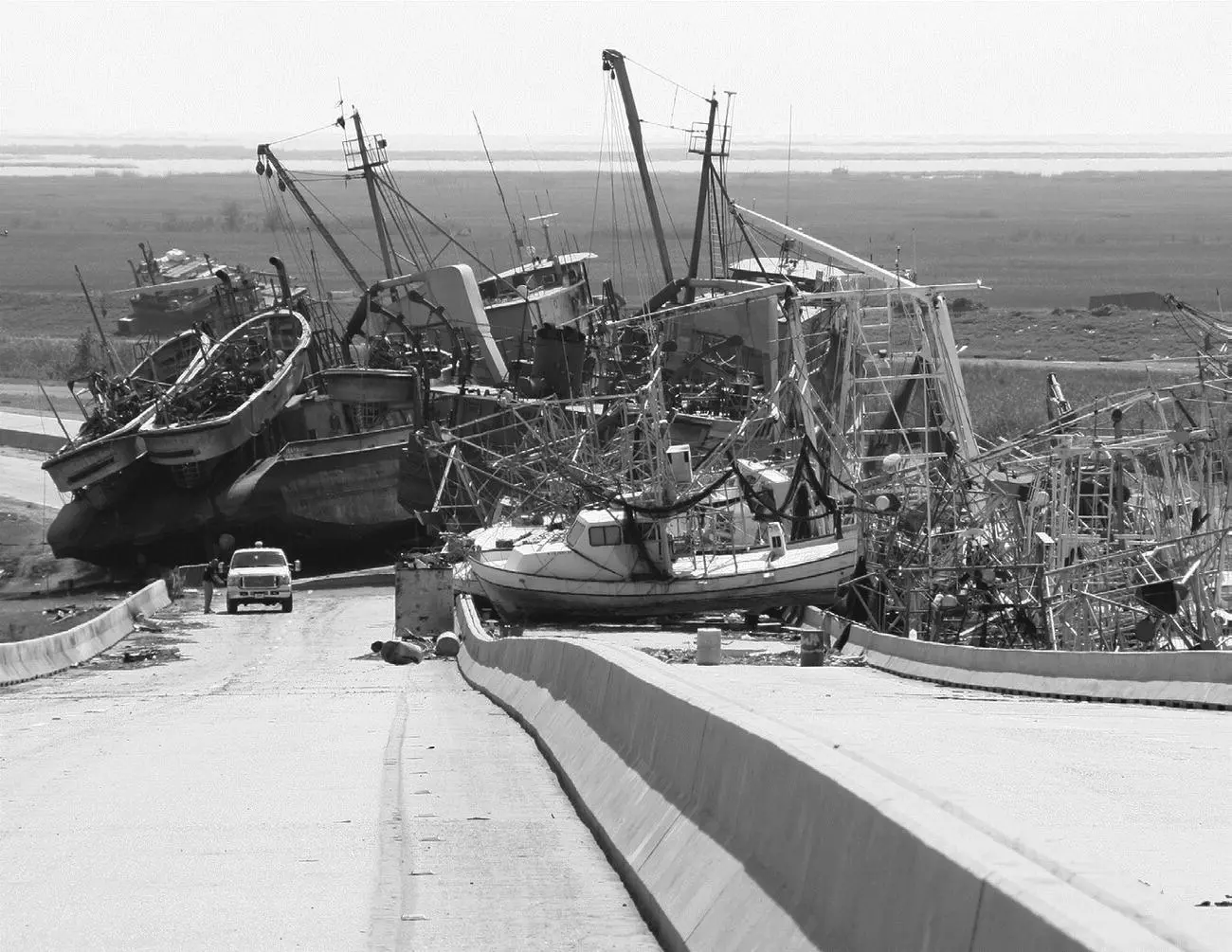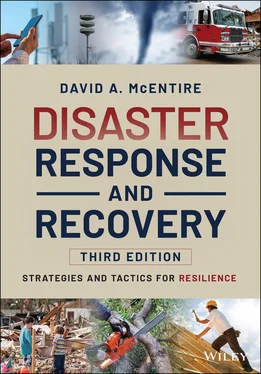David A. McEntire - Disaster Response and Recovery
Здесь есть возможность читать онлайн «David A. McEntire - Disaster Response and Recovery» — ознакомительный отрывок электронной книги совершенно бесплатно, а после прочтения отрывка купить полную версию. В некоторых случаях можно слушать аудио, скачать через торрент в формате fb2 и присутствует краткое содержание. Жанр: unrecognised, на английском языке. Описание произведения, (предисловие) а так же отзывы посетителей доступны на портале библиотеки ЛибКат.
- Название:Disaster Response and Recovery
- Автор:
- Жанр:
- Год:неизвестен
- ISBN:нет данных
- Рейтинг книги:5 / 5. Голосов: 1
-
Избранное:Добавить в избранное
- Отзывы:
-
Ваша оценка:
- 100
- 1
- 2
- 3
- 4
- 5
Disaster Response and Recovery: краткое содержание, описание и аннотация
Предлагаем к чтению аннотацию, описание, краткое содержание или предисловие (зависит от того, что написал сам автор книги «Disaster Response and Recovery»). Если вы не нашли необходимую информацию о книге — напишите в комментариях, мы постараемся отыскать её.
The new edition of the standard textbook in the field, updated with new studies and practical guidelines for reacting to the complexities of today’s disasters Disaster Response and Recovery: Strategies and Tactics for Resilience
Disaster Response and Recovery: Strategies and Tactics for Resilience, Third Edition
Disaster Response and Recovery — читать онлайн ознакомительный отрывок
Ниже представлен текст книги, разбитый по страницам. Система сохранения места последней прочитанной страницы, позволяет с удобством читать онлайн бесплатно книгу «Disaster Response and Recovery», без необходимости каждый раз заново искать на чём Вы остановились. Поставьте закладку, и сможете в любой момент перейти на страницу, на которой закончили чтение.
Интервал:
Закладка:

Figure 1‐8 This picture of boats impacting infrastructure illustrates why Hurricane Katrina was one of the most complex disasters to in U.S. history. Robert Kaufmann/FEMA. http://www.fema.gov/media-library/assets/images/47341
For Example
Disasters and Community Lifelines
FEMA created the “Community Lifelines” concept in order to better comprehend the consequences of disasters and improve communication of those impacts to the public and all pertinent parties involved in emergency management. Community Lifelines are fundamental services that are required to maintain routine operations in society. The lifelines that can be severely disrupted in disasters may include: 1. Safety and Security (including fire service, search and rescue, government service, and community safety); 2. Food, Water, and Shelter (including agriculture); 3. Health and Medical (including medical care, public health, patient movement, medical supply chain, fatality management); 4. Energy (including power grid and fuel); 5. Communications (including infrastructure, responder communications, alert warnings and messages, finance, 911, and dispatch); 6. Transportation (including highway/roadway/motor vehicle, mass transit, railway, aviation, and maritime); and 7. Hazardous materials (including facilities, HAZMAT, pollutants, and contaminants). The Community Lifelines concept was tested in many disasters since 2018, and it is now formalized in the 4th edition of the National Respond Framework (see Chapter 11).
1.5.2 Changes Associated with Disasters
Because of the impacts that become apparent during the immediate emergency period of a disaster, several significant changes may occur, and these could complicate the job of an emergency manager. Tom Drabek, a very well‐known disaster sociologist, has summarized six of them that have been identified in the literature (1986, 46‐47). These include:
1 Uncertainty. In the immediate aftermath of disaster, there is a lack of information about what has happened, why it occurred, the number of injured or dead, the extent of the devastation, and what should be done to deal with these problems.
2 Urgency. As the situation becomes clear and as needs arise, most leaders and citizens desire to act quickly to issue warnings, treat injuries and clear roads of debris among other things.
3 Emergency consensus. Individuals, groups, businesses, government departments, and political leaders agree that major problems have to be addressed and generally work together to overcome them (at least in the immediate aftermath of a disaster).
4 Expansion of citizen role. People are not only more willing to cooperate in a disaster, but they are also likely to be involved in searching for neighbors trapped under debris, transporting the wounded to hospitals, and providing relief supplies to victims through donations to charitable organizations.
5 De‐emphasis of contractual relationships. Because victims’ needs must be met as soon as possible, written agreements are not relied upon. Verbal arrangements are made instead. Accounts and debts are settled when the situation calms down. It is also likely that supplies will be donated with no thought of reimbursement.
6 Convergence. People and material resources will flow to the scene of a disaster. This may include evacuees returning to the location and those wanting information about victims. It may also include volunteers, reporters, researchers, people wanting to take advantage of the situation, groups cheering on the emergency workers, and others mourning those who have died in the event (Kendra and Wachtendorf, 2003).
The above changes can have a dramatic impact on those involved in the management of disasters. Decision making becomes difficult and post‐disaster operations are stressful. Poor communications in disasters complicate the sharing of information. Many agencies and volunteers help to get things done quickly, but the arrival of too many organizations and donations can add to the overwhelming nature of disaster. Resources may be available in a warehouse, but they may not be shipped or tracked in an ineffective manner. Later on, blame may be placed on those considered to be at fault. Disagreements might arise about recovery policies, particularly in regard to disaster assistance and rebuilding priorities. Some of the changes that take place after a disaster have positive features while others are negative. In most cases, the changes resulting from disasters will provide benefits and drawbacks for those working in emergency management and related professions. For instance, more political and financial support may be given to emergency management after a disaster. However, disasters may require long hours, night shifts and even working weekends for those involved in this important endeavor.
1.5.3 The Need for Response and Recovery Operations
Because of the significant consequences of disasters, you must be aware of the goals of response and recovery operations if you are to be an efficacious emergency manager. Such objectives include protecting lives, limiting property loss and overcoming the disruption that disasters cause. There are other priorities that must be considered as well. For instance, you must ensure care for special populations such as those in nursing homes. You must help to coordinate the efforts of all types of disaster participants, regardless if they are affiliated with the government or not. Another desire is to reduce further deterioration of the environment when a disaster occurs and rebuild with future hazards in mind. As you participate in post‐disaster operations, you may rely on both predetermined organizational arrangements and technology to complete these responsibilities. In most disasters, multiple activities will require your focused attention as well as flexibility. Resources should be tracked to help cover expenses. Extreme care should be taken to avoid possible lawsuits. It will be important to record what has transpired so you can learn from your successes and shortcomings.
As can be seen, your job during response and recovery operations is extremely challenging. There are many demands that have to be addressed, and two of them have been identified by Ronald Perry (1991, p. 201):
Agent‐generated demands are the needs made evident by the hazard (e.g., problems resulting from the disaster agent itself). These demands appear immediately as the disaster unfolds, and some examples include sandbags to fight flooding, shelters to care for those made homeless and the restoration of electricity owing to power outages. Figure 1‐9 The damage of electricity infrastructure (an agent‐generated demand) in Crystal Beach, TX, after Hurricane Ike created the need to replace power poles (a response‐generated demand). Greg Henshall/FEMA. http://www.fema.gov/media‐library/assets/images/54764
Response‐generated demands are the needs that are made evident as individuals, organizations, and communities attempt to meet agent‐generated demands. They are visible as people and agencies try to deal with the impact of flooding, earthquakes, and other hazards.
Acquiring sandbags, finding suitable shelter sites, and obtaining portable generators or electricians are examples of response‐generated demands. Response‐generated demands thus deal with the logistical issues pertaining to the reaction of people and organizations to agent‐generated demands ( Figure 1‐9).
In addition to these demands, the author would add a few other expectations placed upon you after a disaster:
Читать дальшеИнтервал:
Закладка:
Похожие книги на «Disaster Response and Recovery»
Представляем Вашему вниманию похожие книги на «Disaster Response and Recovery» списком для выбора. Мы отобрали схожую по названию и смыслу литературу в надежде предоставить читателям больше вариантов отыскать новые, интересные, ещё непрочитанные произведения.
Обсуждение, отзывы о книге «Disaster Response and Recovery» и просто собственные мнения читателей. Оставьте ваши комментарии, напишите, что Вы думаете о произведении, его смысле или главных героях. Укажите что конкретно понравилось, а что нет, и почему Вы так считаете.












